Journal Report: Future Directions in Health Care Management, Nursing
VerifiedAdded on 2022/08/28
|10
|1660
|20
Report
AI Summary
This report presents a comprehensive analysis of three nursing journal articles related to health care management and development, fulfilling the requirements of Learning Activity 6. The first article, "Enhancing nursing education via academic-clinical partnership: An integrative review", examines the benefits of collaboration between academic institutions and clinical settings in improving nursing education and patient outcomes, particularly in resource-poor countries like Malawi. The second article, "Nursing organizational climates in public and private hospitals", investigates the organizational climate in both public and private hospitals, highlighting how factors like employee specialization and individual characteristics influence the work environment and impact patient care. The third article, "Mental health of HIV/AIDS orphans: A review" explores the mental health challenges faced by HIV/AIDS orphans, analyzing various research methodologies and highlighting the need for support and intervention. Each article's methodology, key concepts, results, and recommendations are summarized, providing a detailed overview of the research and its implications for health care management and nursing practice, addressing themes of alliances, corporatization, privatization and public vs. private healthcare.
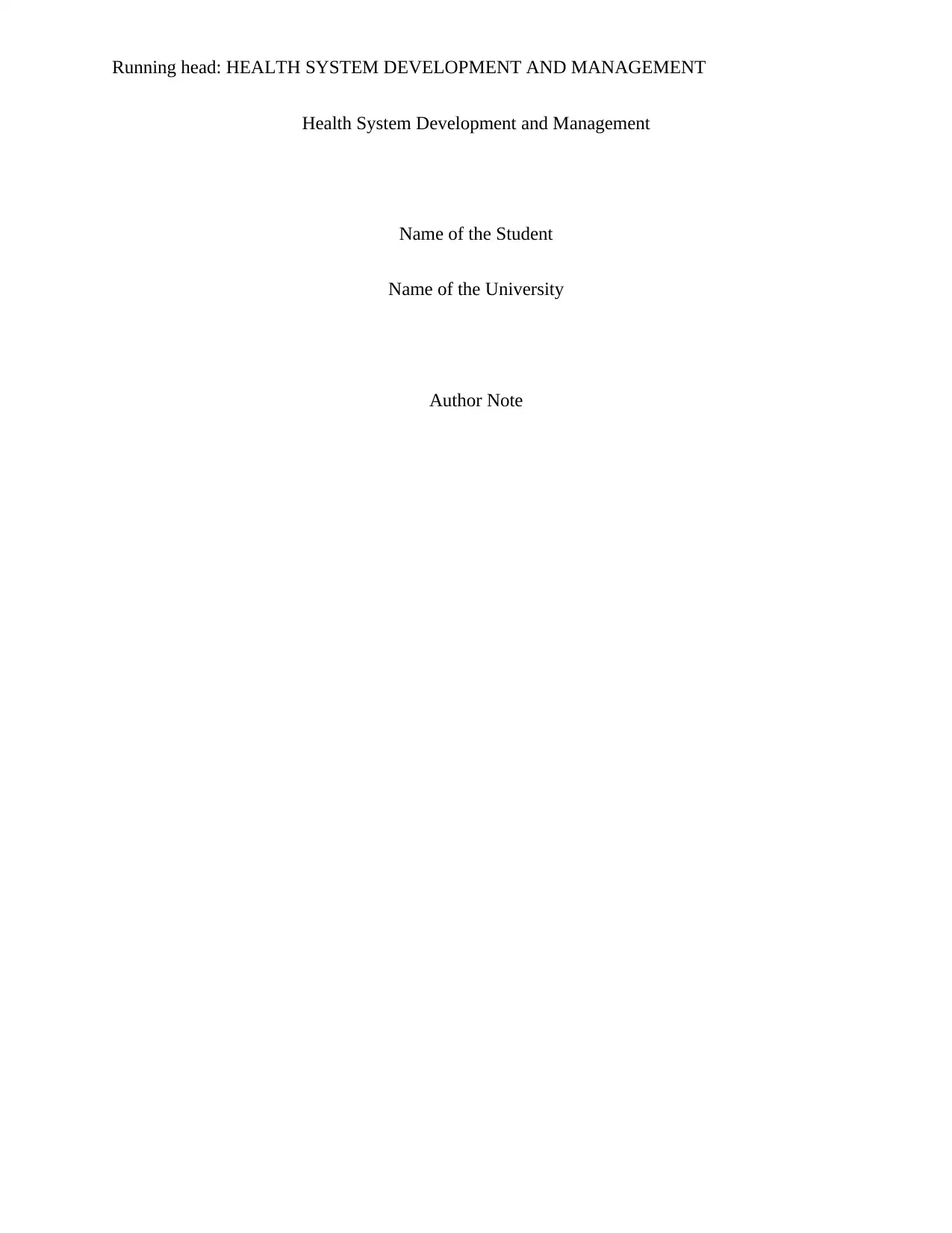
Running head: HEALTH SYSTEM DEVELOPMENT AND MANAGEMENT
Health System Development and Management
Name of the Student
Name of the University
Author Note
Health System Development and Management
Name of the Student
Name of the University
Author Note
Paraphrase This Document
Need a fresh take? Get an instant paraphrase of this document with our AI Paraphraser
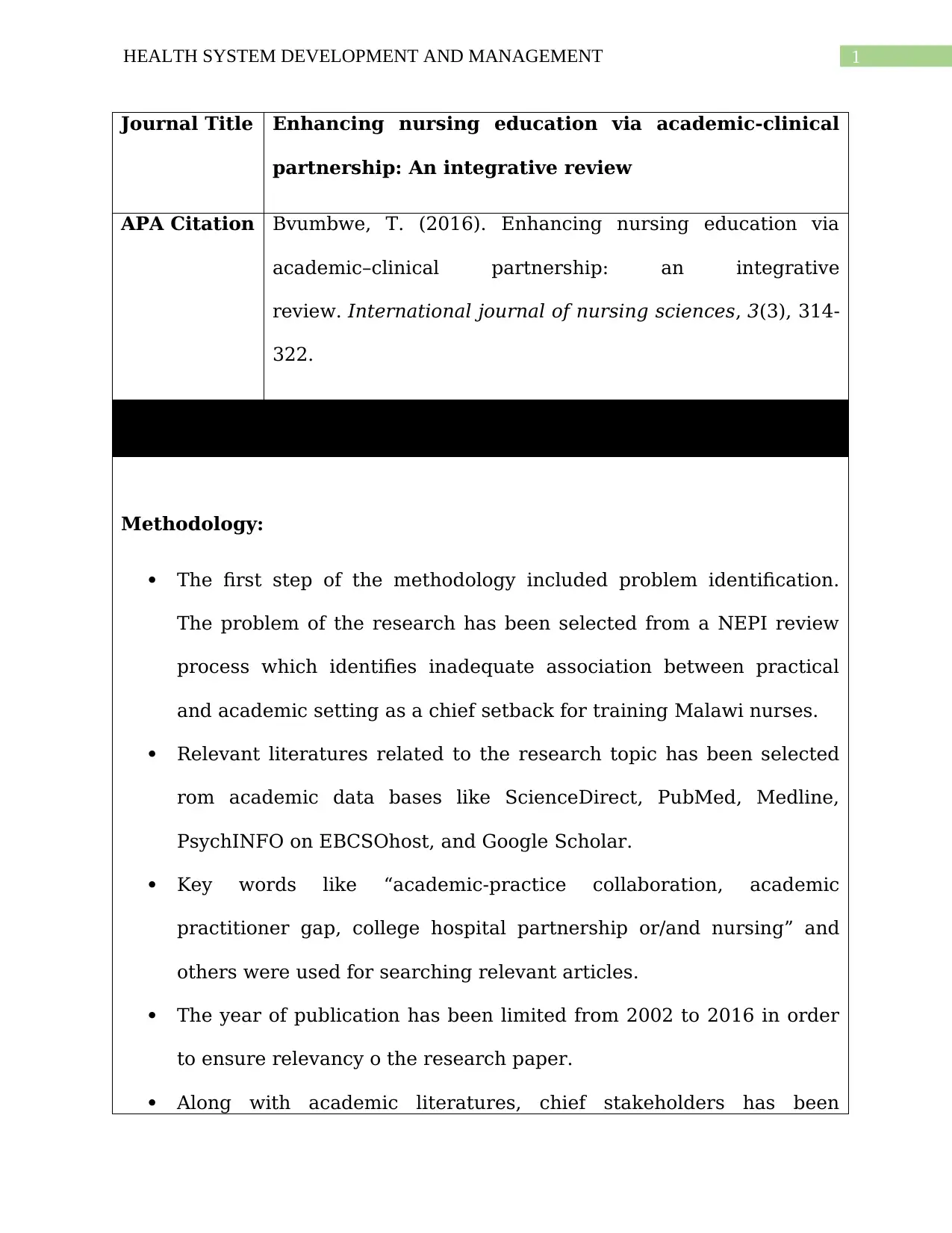
1HEALTH SYSTEM DEVELOPMENT AND MANAGEMENT
Journal Title Enhancing nursing education via academic-clinical
partnership: An integrative review
APA Citation Bvumbwe, T. (2016). Enhancing nursing education via
academic–clinical partnership: an integrative
review. International journal of nursing sciences, 3(3), 314-
322.
Methodology:
The first step of the methodology included problem identification.
The problem of the research has been selected from a NEPI review
process which identifies inadequate association between practical
and academic setting as a chief setback for training Malawi nurses.
Relevant literatures related to the research topic has been selected
rom academic data bases like ScienceDirect, PubMed, Medline,
PsychINFO on EBCSOhost, and Google Scholar.
Key words like “academic-practice collaboration, academic
practitioner gap, college hospital partnership or/and nursing” and
others were used for searching relevant articles.
The year of publication has been limited from 2002 to 2016 in order
to ensure relevancy o the research paper.
Along with academic literatures, chief stakeholders has been
Journal Title Enhancing nursing education via academic-clinical
partnership: An integrative review
APA Citation Bvumbwe, T. (2016). Enhancing nursing education via
academic–clinical partnership: an integrative
review. International journal of nursing sciences, 3(3), 314-
322.
Methodology:
The first step of the methodology included problem identification.
The problem of the research has been selected from a NEPI review
process which identifies inadequate association between practical
and academic setting as a chief setback for training Malawi nurses.
Relevant literatures related to the research topic has been selected
rom academic data bases like ScienceDirect, PubMed, Medline,
PsychINFO on EBCSOhost, and Google Scholar.
Key words like “academic-practice collaboration, academic
practitioner gap, college hospital partnership or/and nursing” and
others were used for searching relevant articles.
The year of publication has been limited from 2002 to 2016 in order
to ensure relevancy o the research paper.
Along with academic literatures, chief stakeholders has been
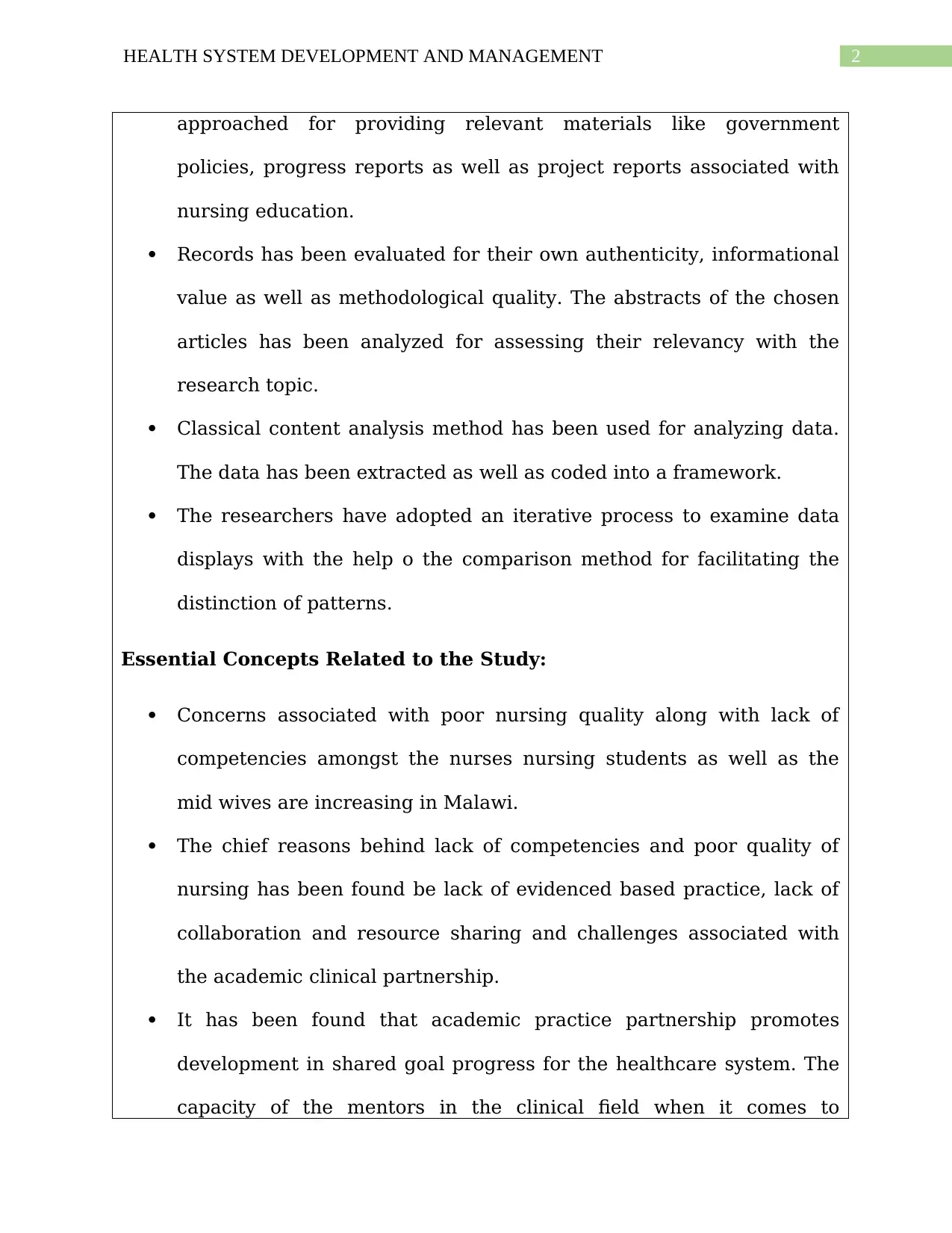
2HEALTH SYSTEM DEVELOPMENT AND MANAGEMENT
approached for providing relevant materials like government
policies, progress reports as well as project reports associated with
nursing education.
Records has been evaluated for their own authenticity, informational
value as well as methodological quality. The abstracts of the chosen
articles has been analyzed for assessing their relevancy with the
research topic.
Classical content analysis method has been used for analyzing data.
The data has been extracted as well as coded into a framework.
The researchers have adopted an iterative process to examine data
displays with the help o the comparison method for facilitating the
distinction of patterns.
Essential Concepts Related to the Study:
Concerns associated with poor nursing quality along with lack of
competencies amongst the nurses nursing students as well as the
mid wives are increasing in Malawi.
The chief reasons behind lack of competencies and poor quality of
nursing has been found be lack of evidenced based practice, lack of
collaboration and resource sharing and challenges associated with
the academic clinical partnership.
It has been found that academic practice partnership promotes
development in shared goal progress for the healthcare system. The
capacity of the mentors in the clinical field when it comes to
approached for providing relevant materials like government
policies, progress reports as well as project reports associated with
nursing education.
Records has been evaluated for their own authenticity, informational
value as well as methodological quality. The abstracts of the chosen
articles has been analyzed for assessing their relevancy with the
research topic.
Classical content analysis method has been used for analyzing data.
The data has been extracted as well as coded into a framework.
The researchers have adopted an iterative process to examine data
displays with the help o the comparison method for facilitating the
distinction of patterns.
Essential Concepts Related to the Study:
Concerns associated with poor nursing quality along with lack of
competencies amongst the nurses nursing students as well as the
mid wives are increasing in Malawi.
The chief reasons behind lack of competencies and poor quality of
nursing has been found be lack of evidenced based practice, lack of
collaboration and resource sharing and challenges associated with
the academic clinical partnership.
It has been found that academic practice partnership promotes
development in shared goal progress for the healthcare system. The
capacity of the mentors in the clinical field when it comes to
⊘ This is a preview!⊘
Do you want full access?
Subscribe today to unlock all pages.

Trusted by 1+ million students worldwide
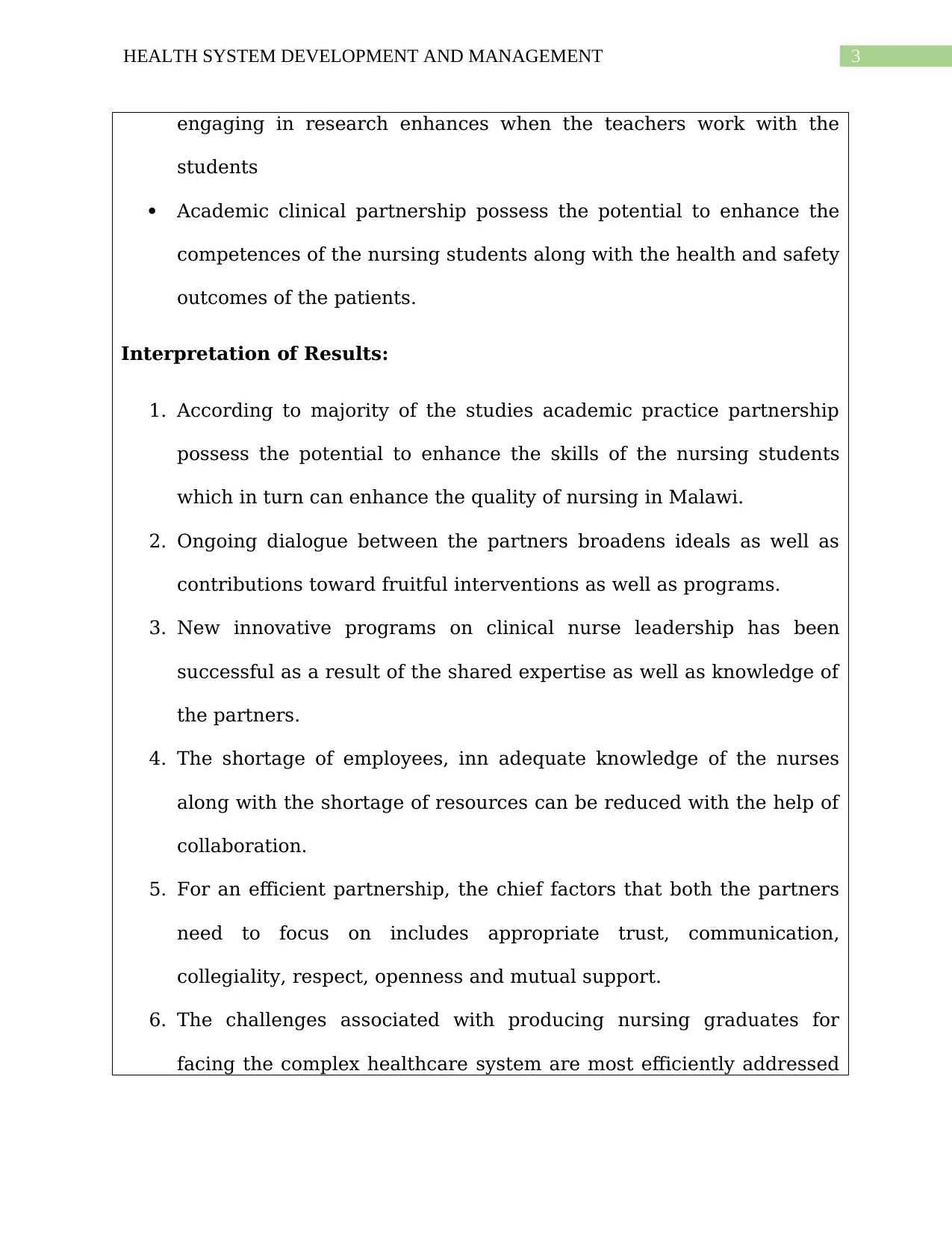
3HEALTH SYSTEM DEVELOPMENT AND MANAGEMENT
engaging in research enhances when the teachers work with the
students
Academic clinical partnership possess the potential to enhance the
competences of the nursing students along with the health and safety
outcomes of the patients.
Interpretation of Results:
1. According to majority of the studies academic practice partnership
possess the potential to enhance the skills of the nursing students
which in turn can enhance the quality of nursing in Malawi.
2. Ongoing dialogue between the partners broadens ideals as well as
contributions toward fruitful interventions as well as programs.
3. New innovative programs on clinical nurse leadership has been
successful as a result of the shared expertise as well as knowledge of
the partners.
4. The shortage of employees, inn adequate knowledge of the nurses
along with the shortage of resources can be reduced with the help of
collaboration.
5. For an efficient partnership, the chief factors that both the partners
need to focus on includes appropriate trust, communication,
collegiality, respect, openness and mutual support.
6. The challenges associated with producing nursing graduates for
facing the complex healthcare system are most efficiently addressed
engaging in research enhances when the teachers work with the
students
Academic clinical partnership possess the potential to enhance the
competences of the nursing students along with the health and safety
outcomes of the patients.
Interpretation of Results:
1. According to majority of the studies academic practice partnership
possess the potential to enhance the skills of the nursing students
which in turn can enhance the quality of nursing in Malawi.
2. Ongoing dialogue between the partners broadens ideals as well as
contributions toward fruitful interventions as well as programs.
3. New innovative programs on clinical nurse leadership has been
successful as a result of the shared expertise as well as knowledge of
the partners.
4. The shortage of employees, inn adequate knowledge of the nurses
along with the shortage of resources can be reduced with the help of
collaboration.
5. For an efficient partnership, the chief factors that both the partners
need to focus on includes appropriate trust, communication,
collegiality, respect, openness and mutual support.
6. The challenges associated with producing nursing graduates for
facing the complex healthcare system are most efficiently addressed
Paraphrase This Document
Need a fresh take? Get an instant paraphrase of this document with our AI Paraphraser
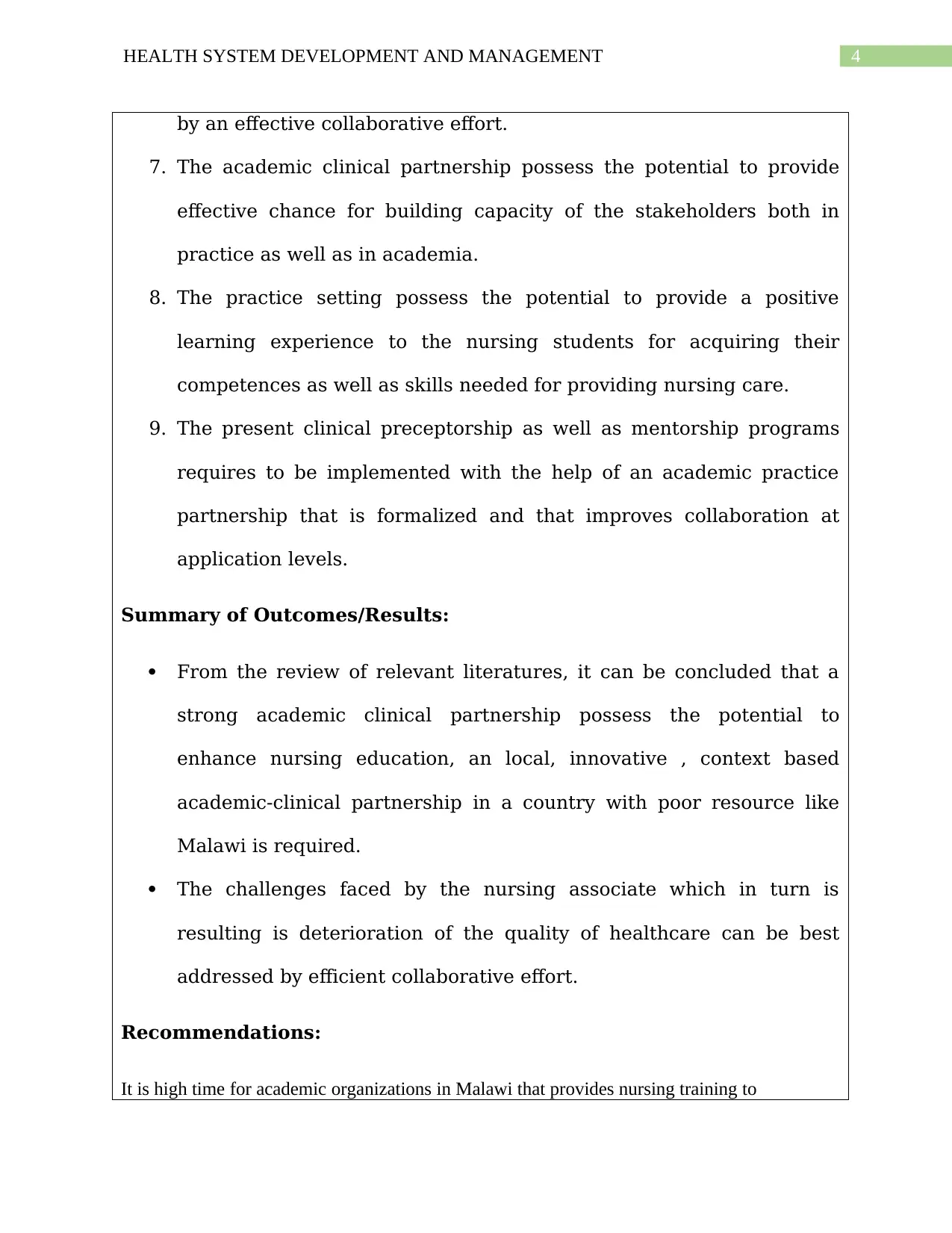
4HEALTH SYSTEM DEVELOPMENT AND MANAGEMENT
by an effective collaborative effort.
7. The academic clinical partnership possess the potential to provide
effective chance for building capacity of the stakeholders both in
practice as well as in academia.
8. The practice setting possess the potential to provide a positive
learning experience to the nursing students for acquiring their
competences as well as skills needed for providing nursing care.
9. The present clinical preceptorship as well as mentorship programs
requires to be implemented with the help of an academic practice
partnership that is formalized and that improves collaboration at
application levels.
Summary of Outcomes/Results:
From the review of relevant literatures, it can be concluded that a
strong academic clinical partnership possess the potential to
enhance nursing education, an local, innovative , context based
academic-clinical partnership in a country with poor resource like
Malawi is required.
The challenges faced by the nursing associate which in turn is
resulting is deterioration of the quality of healthcare can be best
addressed by efficient collaborative effort.
Recommendations:
It is high time for academic organizations in Malawi that provides nursing training to
by an effective collaborative effort.
7. The academic clinical partnership possess the potential to provide
effective chance for building capacity of the stakeholders both in
practice as well as in academia.
8. The practice setting possess the potential to provide a positive
learning experience to the nursing students for acquiring their
competences as well as skills needed for providing nursing care.
9. The present clinical preceptorship as well as mentorship programs
requires to be implemented with the help of an academic practice
partnership that is formalized and that improves collaboration at
application levels.
Summary of Outcomes/Results:
From the review of relevant literatures, it can be concluded that a
strong academic clinical partnership possess the potential to
enhance nursing education, an local, innovative , context based
academic-clinical partnership in a country with poor resource like
Malawi is required.
The challenges faced by the nursing associate which in turn is
resulting is deterioration of the quality of healthcare can be best
addressed by efficient collaborative effort.
Recommendations:
It is high time for academic organizations in Malawi that provides nursing training to
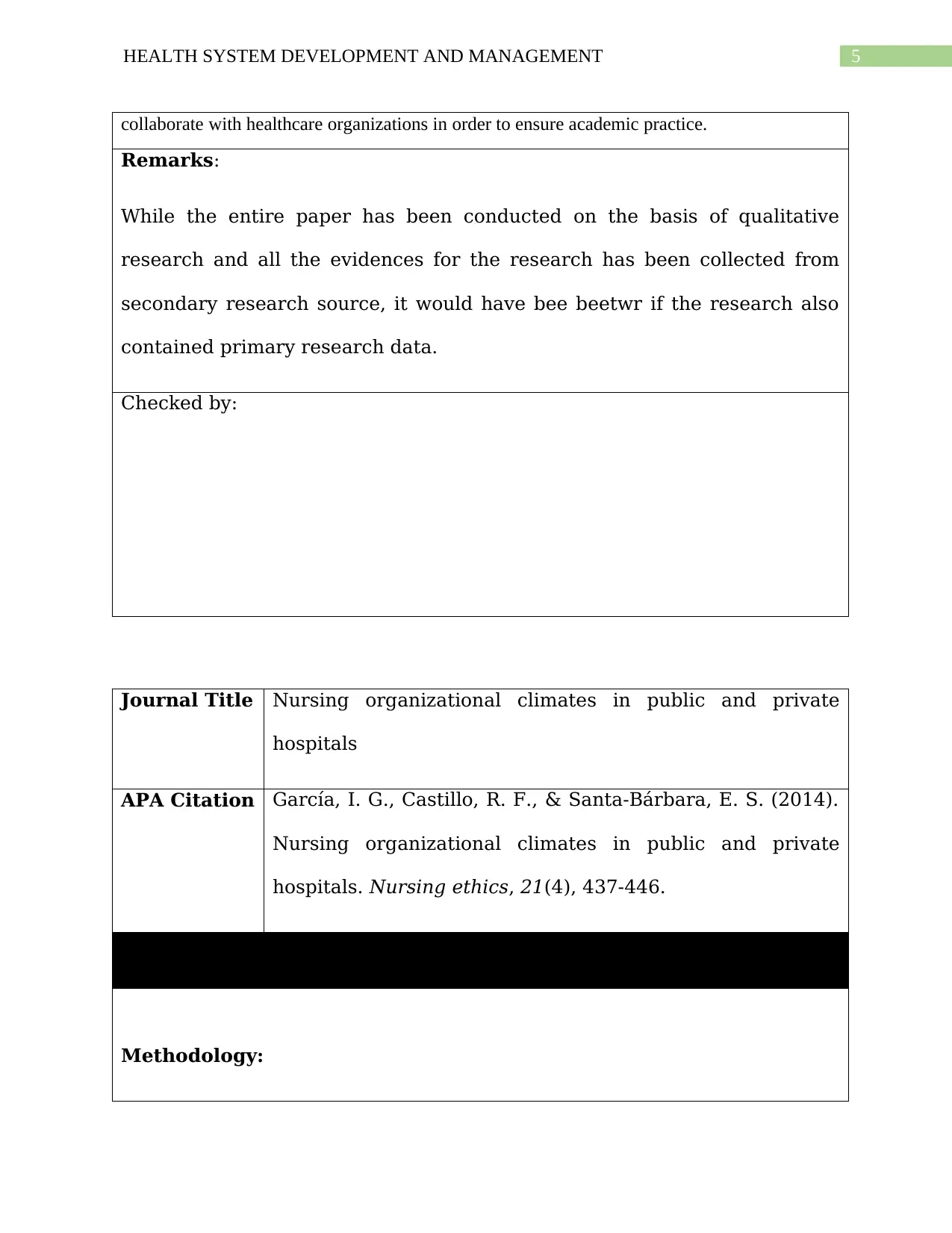
5HEALTH SYSTEM DEVELOPMENT AND MANAGEMENT
collaborate with healthcare organizations in order to ensure academic practice.
Remarks:
While the entire paper has been conducted on the basis of qualitative
research and all the evidences for the research has been collected from
secondary research source, it would have bee beetwr if the research also
contained primary research data.
Checked by:
Journal Title Nursing organizational climates in public and private
hospitals
APA Citation García, I. G., Castillo, R. F., & Santa-Bárbara, E. S. (2014).
Nursing organizational climates in public and private
hospitals. Nursing ethics, 21(4), 437-446.
Methodology:
collaborate with healthcare organizations in order to ensure academic practice.
Remarks:
While the entire paper has been conducted on the basis of qualitative
research and all the evidences for the research has been collected from
secondary research source, it would have bee beetwr if the research also
contained primary research data.
Checked by:
Journal Title Nursing organizational climates in public and private
hospitals
APA Citation García, I. G., Castillo, R. F., & Santa-Bárbara, E. S. (2014).
Nursing organizational climates in public and private
hospitals. Nursing ethics, 21(4), 437-446.
Methodology:
⊘ This is a preview!⊘
Do you want full access?
Subscribe today to unlock all pages.

Trusted by 1+ million students worldwide
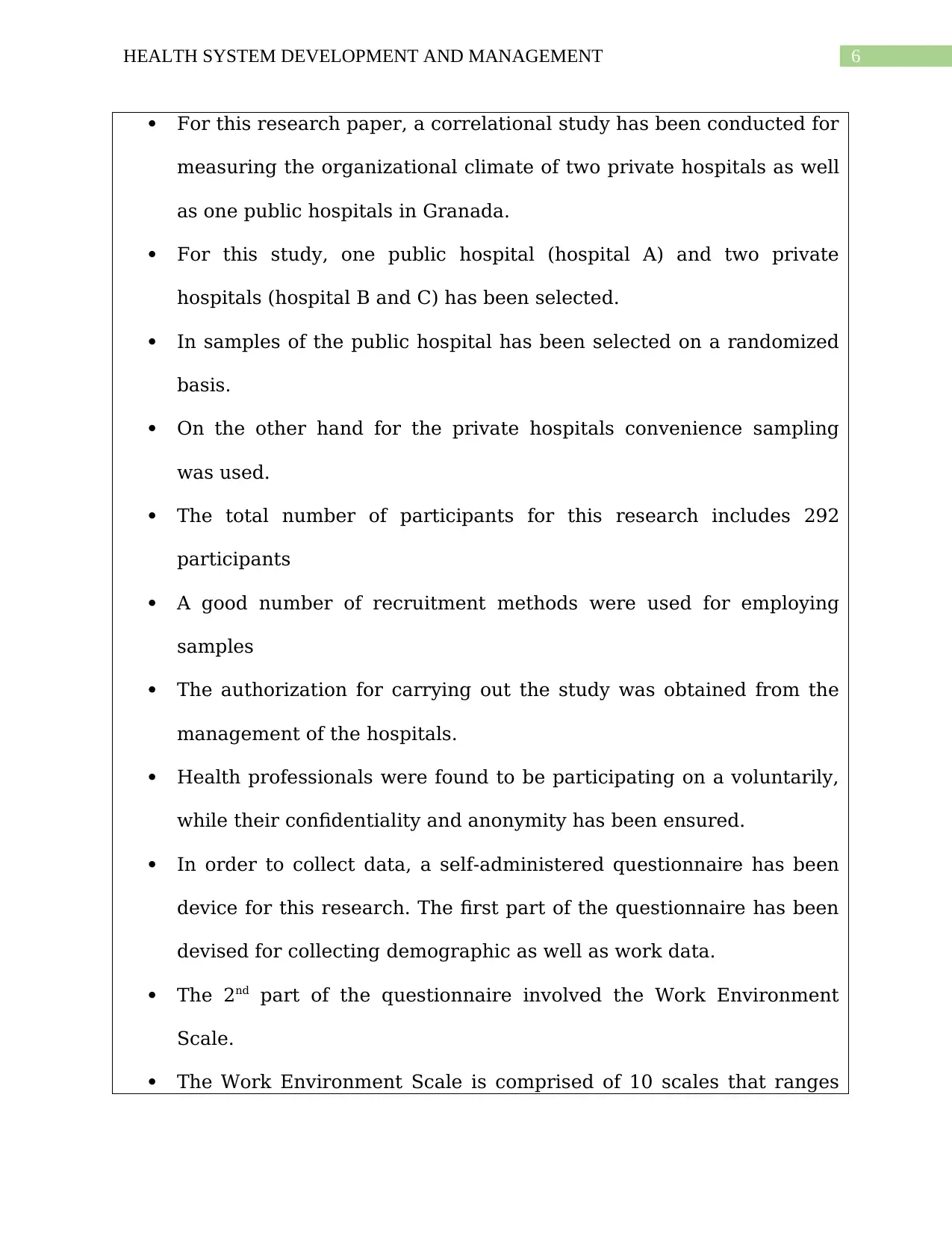
6HEALTH SYSTEM DEVELOPMENT AND MANAGEMENT
For this research paper, a correlational study has been conducted for
measuring the organizational climate of two private hospitals as well
as one public hospitals in Granada.
For this study, one public hospital (hospital A) and two private
hospitals (hospital B and C) has been selected.
In samples of the public hospital has been selected on a randomized
basis.
On the other hand for the private hospitals convenience sampling
was used.
The total number of participants for this research includes 292
participants
A good number of recruitment methods were used for employing
samples
The authorization for carrying out the study was obtained from the
management of the hospitals.
Health professionals were found to be participating on a voluntarily,
while their confidentiality and anonymity has been ensured.
In order to collect data, a self-administered questionnaire has been
device for this research. The first part of the questionnaire has been
devised for collecting demographic as well as work data.
The 2nd part of the questionnaire involved the Work Environment
Scale.
The Work Environment Scale is comprised of 10 scales that ranges
For this research paper, a correlational study has been conducted for
measuring the organizational climate of two private hospitals as well
as one public hospitals in Granada.
For this study, one public hospital (hospital A) and two private
hospitals (hospital B and C) has been selected.
In samples of the public hospital has been selected on a randomized
basis.
On the other hand for the private hospitals convenience sampling
was used.
The total number of participants for this research includes 292
participants
A good number of recruitment methods were used for employing
samples
The authorization for carrying out the study was obtained from the
management of the hospitals.
Health professionals were found to be participating on a voluntarily,
while their confidentiality and anonymity has been ensured.
In order to collect data, a self-administered questionnaire has been
device for this research. The first part of the questionnaire has been
devised for collecting demographic as well as work data.
The 2nd part of the questionnaire involved the Work Environment
Scale.
The Work Environment Scale is comprised of 10 scales that ranges
Paraphrase This Document
Need a fresh take? Get an instant paraphrase of this document with our AI Paraphraser
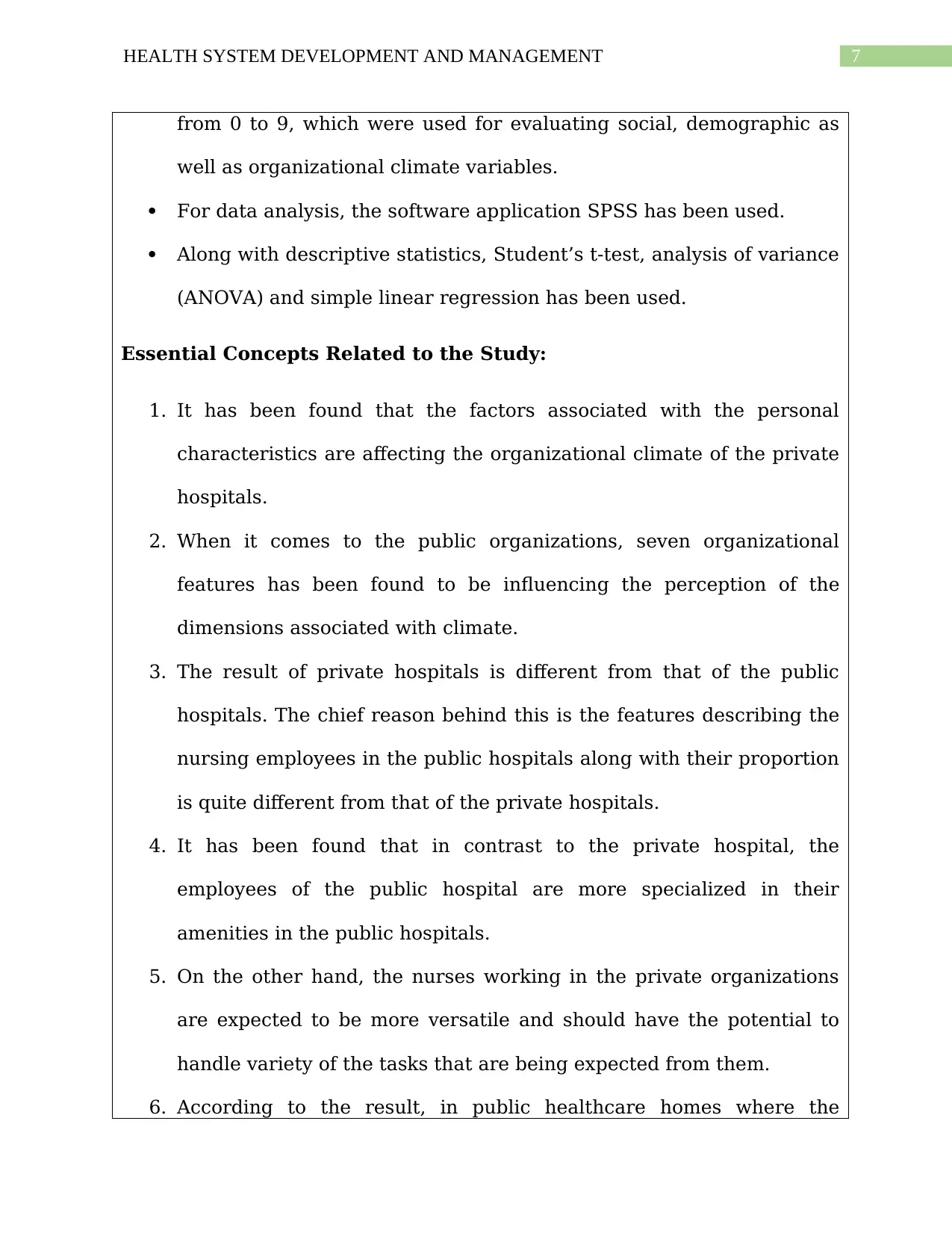
7HEALTH SYSTEM DEVELOPMENT AND MANAGEMENT
from 0 to 9, which were used for evaluating social, demographic as
well as organizational climate variables.
For data analysis, the software application SPSS has been used.
Along with descriptive statistics, Student’s t-test, analysis of variance
(ANOVA) and simple linear regression has been used.
Essential Concepts Related to the Study:
1. It has been found that the factors associated with the personal
characteristics are affecting the organizational climate of the private
hospitals.
2. When it comes to the public organizations, seven organizational
features has been found to be influencing the perception of the
dimensions associated with climate.
3. The result of private hospitals is different from that of the public
hospitals. The chief reason behind this is the features describing the
nursing employees in the public hospitals along with their proportion
is quite different from that of the private hospitals.
4. It has been found that in contrast to the private hospital, the
employees of the public hospital are more specialized in their
amenities in the public hospitals.
5. On the other hand, the nurses working in the private organizations
are expected to be more versatile and should have the potential to
handle variety of the tasks that are being expected from them.
6. According to the result, in public healthcare homes where the
from 0 to 9, which were used for evaluating social, demographic as
well as organizational climate variables.
For data analysis, the software application SPSS has been used.
Along with descriptive statistics, Student’s t-test, analysis of variance
(ANOVA) and simple linear regression has been used.
Essential Concepts Related to the Study:
1. It has been found that the factors associated with the personal
characteristics are affecting the organizational climate of the private
hospitals.
2. When it comes to the public organizations, seven organizational
features has been found to be influencing the perception of the
dimensions associated with climate.
3. The result of private hospitals is different from that of the public
hospitals. The chief reason behind this is the features describing the
nursing employees in the public hospitals along with their proportion
is quite different from that of the private hospitals.
4. It has been found that in contrast to the private hospital, the
employees of the public hospital are more specialized in their
amenities in the public hospitals.
5. On the other hand, the nurses working in the private organizations
are expected to be more versatile and should have the potential to
handle variety of the tasks that are being expected from them.
6. According to the result, in public healthcare homes where the
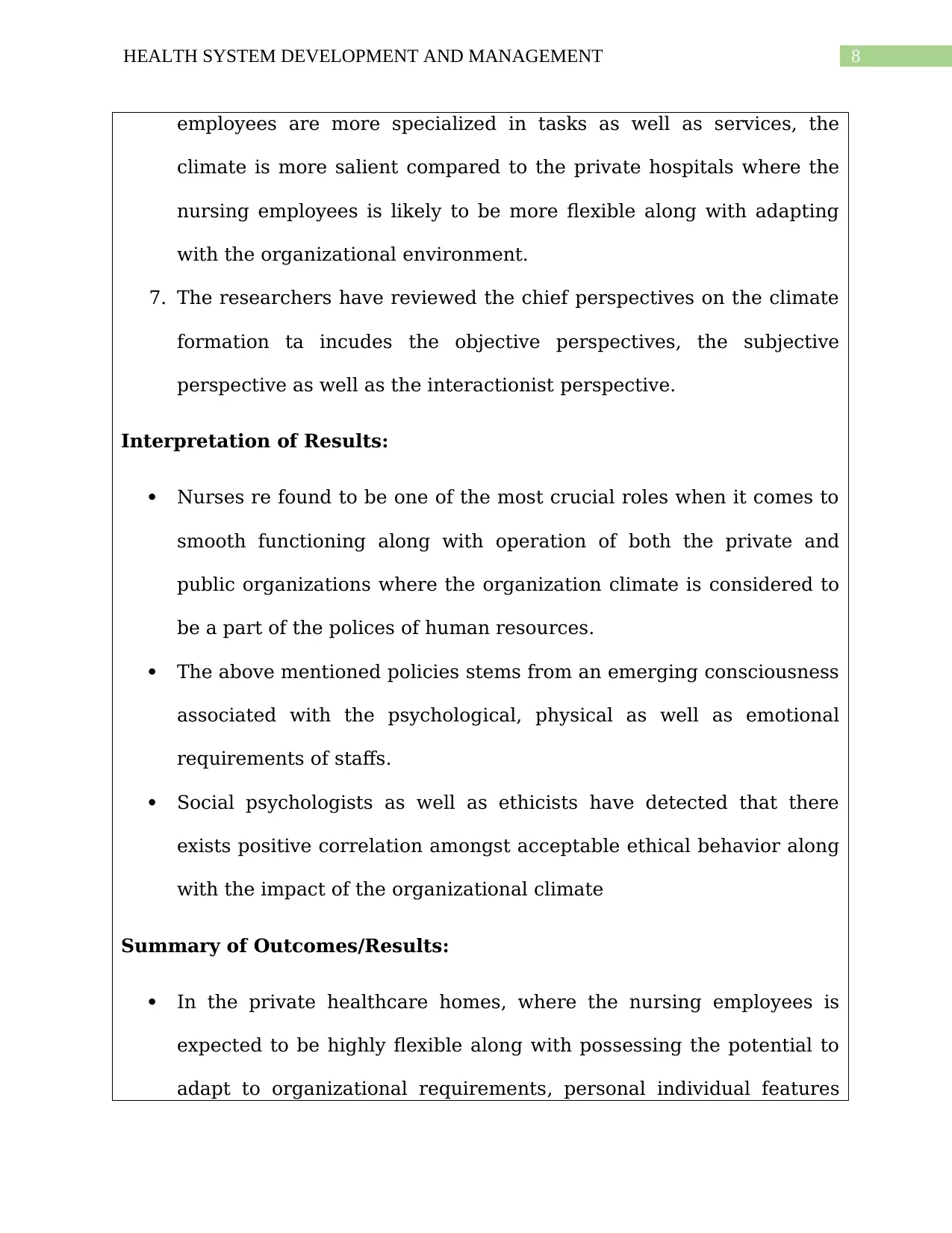
8HEALTH SYSTEM DEVELOPMENT AND MANAGEMENT
employees are more specialized in tasks as well as services, the
climate is more salient compared to the private hospitals where the
nursing employees is likely to be more flexible along with adapting
with the organizational environment.
7. The researchers have reviewed the chief perspectives on the climate
formation ta incudes the objective perspectives, the subjective
perspective as well as the interactionist perspective.
Interpretation of Results:
Nurses re found to be one of the most crucial roles when it comes to
smooth functioning along with operation of both the private and
public organizations where the organization climate is considered to
be a part of the polices of human resources.
The above mentioned policies stems from an emerging consciousness
associated with the psychological, physical as well as emotional
requirements of staffs.
Social psychologists as well as ethicists have detected that there
exists positive correlation amongst acceptable ethical behavior along
with the impact of the organizational climate
Summary of Outcomes/Results:
In the private healthcare homes, where the nursing employees is
expected to be highly flexible along with possessing the potential to
adapt to organizational requirements, personal individual features
employees are more specialized in tasks as well as services, the
climate is more salient compared to the private hospitals where the
nursing employees is likely to be more flexible along with adapting
with the organizational environment.
7. The researchers have reviewed the chief perspectives on the climate
formation ta incudes the objective perspectives, the subjective
perspective as well as the interactionist perspective.
Interpretation of Results:
Nurses re found to be one of the most crucial roles when it comes to
smooth functioning along with operation of both the private and
public organizations where the organization climate is considered to
be a part of the polices of human resources.
The above mentioned policies stems from an emerging consciousness
associated with the psychological, physical as well as emotional
requirements of staffs.
Social psychologists as well as ethicists have detected that there
exists positive correlation amongst acceptable ethical behavior along
with the impact of the organizational climate
Summary of Outcomes/Results:
In the private healthcare homes, where the nursing employees is
expected to be highly flexible along with possessing the potential to
adapt to organizational requirements, personal individual features
⊘ This is a preview!⊘
Do you want full access?
Subscribe today to unlock all pages.

Trusted by 1+ million students worldwide
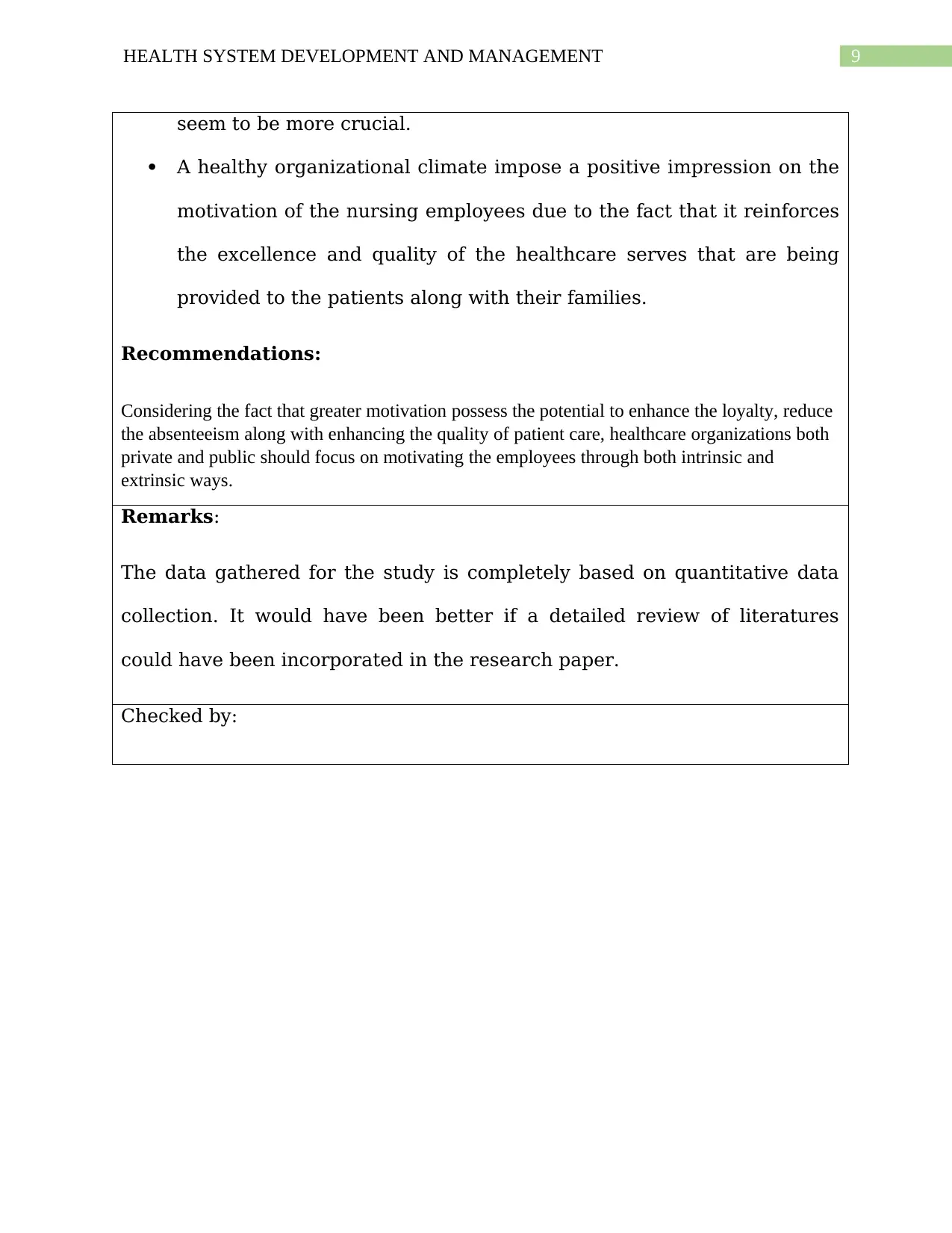
9HEALTH SYSTEM DEVELOPMENT AND MANAGEMENT
seem to be more crucial.
A healthy organizational climate impose a positive impression on the
motivation of the nursing employees due to the fact that it reinforces
the excellence and quality of the healthcare serves that are being
provided to the patients along with their families.
Recommendations:
Considering the fact that greater motivation possess the potential to enhance the loyalty, reduce
the absenteeism along with enhancing the quality of patient care, healthcare organizations both
private and public should focus on motivating the employees through both intrinsic and
extrinsic ways.
Remarks:
The data gathered for the study is completely based on quantitative data
collection. It would have been better if a detailed review of literatures
could have been incorporated in the research paper.
Checked by:
seem to be more crucial.
A healthy organizational climate impose a positive impression on the
motivation of the nursing employees due to the fact that it reinforces
the excellence and quality of the healthcare serves that are being
provided to the patients along with their families.
Recommendations:
Considering the fact that greater motivation possess the potential to enhance the loyalty, reduce
the absenteeism along with enhancing the quality of patient care, healthcare organizations both
private and public should focus on motivating the employees through both intrinsic and
extrinsic ways.
Remarks:
The data gathered for the study is completely based on quantitative data
collection. It would have been better if a detailed review of literatures
could have been incorporated in the research paper.
Checked by:
1 out of 10
Related Documents
Your All-in-One AI-Powered Toolkit for Academic Success.
+13062052269
info@desklib.com
Available 24*7 on WhatsApp / Email
![[object Object]](/_next/static/media/star-bottom.7253800d.svg)
Unlock your academic potential
Copyright © 2020–2025 A2Z Services. All Rights Reserved. Developed and managed by ZUCOL.





